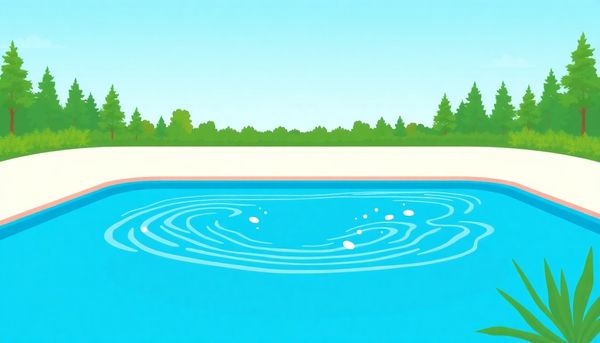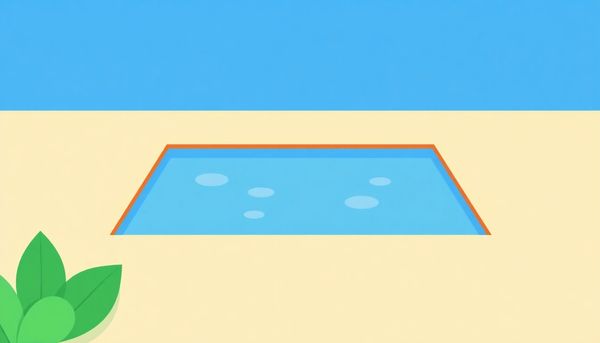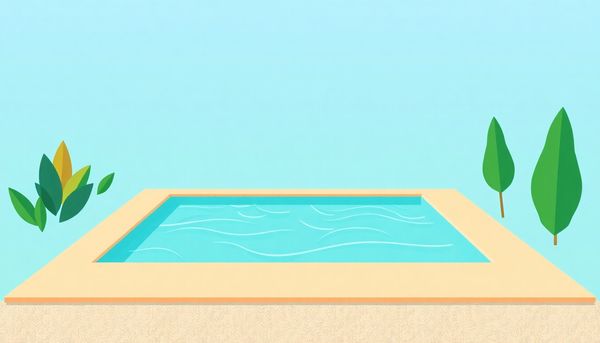Master Pool Clarity: The Truth About Phosphates and Algae Control
November 21th, 2024
November 21th, 2024
The sun blazes overhead, casting sparkling reflections on the inviting surface of a swimming pool. For many, pools are synonymous with summer fun and relaxation. Yet, beneath the shimmering veneer, an unseen element quietly influences the quality of the water: phosphates. Often overlooked, these compounds can have a surprisingly significant impact on the aquatic environment of your pool.
In my own backyard, the battle with phosphates first became apparent when a once-crystal-clear swimming oasis began to show signs of unwelcome algae growth. This was puzzling; regular cleaning and chemical treatments were religiously adhered to. It wasn’t until a seasoned pool technician pointed out the elevated phosphate levels that the mystery began to unravel.
Understanding phosphates is essential for any pool owner aiming to maintain a pristine pool. These organic compounds are everywhere—in fertilizers, detergents, even rainwater—all of which can wash into your pool and create a feast for algae. Algae, as it turns out, thrive on phosphates, leading to murky water that’s not only unattractive but potentially harmful if left unchecked.
This guide will explore how phosphates find their way into your pool, the effects they have on water quality, and practical strategies to manage them. As we delve into the depths of phosphate management, you’ll gain insights that could make the difference between a pool that merely functions and one that sparkles invitingly throughout the season.

Shall we unravel some of the myths surrounding phosphates in pool water? Many pool owners have been led to believe that phosphates are the primary culprit in algae growth, akin to a rogue ingredient in a recipe. While it’s true that phosphates serve as a food source for algae, focusing solely on their removal is akin to trying to solve a puzzle with a single piece.
Consider this: a few summers ago, my neighbor was convinced that phosphates were the bane of her pool’s existence. She invested in a stockpile of phosphate removers, yet algae still flourished. It was only when she adjusted her chlorine levels and incorporated a regular algaecide routine that her pool’s clarity returned. This experience exemplifies a truth often overlooked: it's not the phosphates that need to be purged, but the conditions they thrive in that need managing.
Moreover, phosphate removers often contain chemicals like lanthanum, which, while effective at their job, introduce their own environmental concerns. Worrying over phosphates can distract from more impactful maintenance practices, such as ensuring proper filtration and sanitation. Ultimately, by focusing on maintaining balanced chlorine levels, utilizing algaecides, and performing regular pool shocks, you can ensure your pool remains a sparkling oasis without the need for unnecessary chemical interventions.
In the world of pool maintenance, myths and misconceptions swirl around like leaves in a gusty wind. One of the most persistent debates centers on phosphates and their alleged role as a sinister catalyst for algae growth. Some might tell you that phosphates are the primary villains to vanquish in the quest for a pristine pool, yet this narrative often overlooks the bigger picture.
Consider this: a friend of mine tirelessly battled algae in her backyard oasis, religiously using phosphate removers with little success. Frustrated, she decided to shift her focus back to maintaining optimal chlorine levels and incorporating a reliable algaecide into her routine. The result? Her pool sparkled, algae-free, without the need for costly phosphate treatments.
Phosphate removers may seem like a straightforward solution, but they often serve as a distraction from the core issue—improper sanitization. Algae blooms thrive not because phosphates are present, but because the sanitizer levels are insufficient to keep them at bay. Much like applying sunscreen is more about protecting against sunburn than combating heat, maintaining chlorine levels is the effective way to manage algae.
So, before you reach for that phosphate remover, remember that your pool’s clarity lies not in eliminating phosphates, but in ensuring a robust defense with chlorine and algaecide. This approach not only saves money but also prevents unnecessary exposure to potentially harmful chemicals. Dive into the facts, and you’ll find that effective pool care is as much about understanding the water as it is about treating it.
Every pool owner knows that the sight of algae is enough to send shivers down your spine. It’s a dreaded invader that turns your pristine oasis into a murky swamp. The knee-jerk reaction might be to bust out the phosphate removers, lured by the promise of cutting off algae's food supply. But let’s hit pause on that notion for a moment. Think of algae control like getting rid of weeds in a garden. Would you spray the whole area with weed killer or just pluck the few that actually sprout? In pools, the trick is not in starving algae but preventing its presence altogether.
Effective algae control is rooted in maintaining the right balance of chlorine. Chlorine acts as both guardian and mercenary, warding off algae before it even gets a foothold. Regularly testing and adjusting chlorine levels ensures that algae doesn't stand a chance to bloom. And don’t forget about algaecides—they serve as a secondary line of defense, a deterrent that keeps new algae spores from thinking your pool is a good place to settle.
Personal experience is the best teacher. I’ve seen it in countless pool parties where a simple adherence to routine checks and maintenance keeps the water sparkling clear. Occasionally shocking the pool, like giving it a fresh reboot, further guarantees that any sneaky algae spores are nipped in the bud. Prioritizing these practices over costly phosphate removers not only saves money but also guarantees peace of mind, letting you enjoy your pool exactly as it should be—inviting and crystal clear.
In the labyrinth of pool maintenance, adding chemicals often seems like the easiest solution. But, before reaching for another pool product, consider the broader impact it might have—not just on your wallet but on your pool’s ecosystem. Many pool owners, caught in the phosphate panic, splurge on removers that promise to keep algae at bay. Yet, relying on these chemicals can be like swatting at shadows when the sun is right in front of you.
Think of it this way: the most effective way to manage algae is not by eliminating its food source but by ensuring it can't thrive in the first place. Phosphates are indeed a feast for algae, but if your chlorine levels are optimal and coupled with a regular algaecide regimen, algae won’t stand a chance. My own experience with pool care taught me that consistent basic maintenance trumps the latest chemical fad—keeping things simple led to a clearer pool and fewer headaches.
Moreover, the environmental implications of unnecessary chemical use can’t be ignored. Phosphate removers often contain lanthanum, a substance with potential ecological toxicity. Introducing it into your pool can inadvertently harm your backyard’s micro-ecosystem. By sidestepping unnecessary chemical additions, you're making a responsible choice for both your pool and the environment. Embrace simplicity, and your swimming sessions will be all about fun, not fuss.

Chlorine often emerges as the unsung hero in the battle against pool algae. While the conversation around phosphates tends to dominate pool care discussions, chlorine is the real champion you should focus on. It’s akin to the trusty old friend who’s always been there, ready to lend a hand when things get murky. My neighbor swore by phosphate removers until I shared my chlorine-centric success story with him. A properly chlorinated pool is like a fortress, a place where algae simply cannot survive. Maintaining consistently adequate chlorine levels ensures a hostile environment for algae, rendering phosphates powerless.
Consider the power of chlorine as a preventative measure rather than a reactionary fix. Regular pool shock treatments and algaecide applications, coupled with robust chlorine maintenance, create an inhospitable setting for unwanted growth. Just like keeping your home clean deters pests, a well-chlorinated pool deters algae. I remember the first time I took this approach; the difference was night and day. My pool not only stayed sparkling clean, but I found myself spending less time and money on additional chemicals. In essence, prioritizing chlorine isn't just about keeping algae at bay—it's about adopting a more sustainable, cost-effective pool care strategy that aligns with long-term maintenance goals.
In the bustling world of pool maintenance, chlorine stands out as the reliable guardian against algae. A friend of mine, who owns a beautifully maintained pool, once shared how she initially believed the hype about phosphate removers. She spent quite a bit on them, only to realize that her real ally was chlorine all along.
Chlorine, when used correctly, serves as an efficient weapon against algae. Maintaining proper chlorine levels not only sanitizes the water but creates an environment where algae struggle to survive. Think of chlorine as the unseen lifeguard patrolling the waters, ready to tackle any unwelcome visitors. Consistent chlorination is crucial—consider periodic testing and adjustment to keep levels optimal.
Supplementing this with a trusted algaecide adds an extra layer of protection, creating a chemical barrier that algae find nearly impossible to breach. And then there’s the big gun: the pool shock. A good shock treatment delivers a potent dose of chlorine, wiping out any lurking contaminants, including the pesky algae.
Investing in these practices is smarter and more economical than chasing phosphates. While phosphates feed algae, the truth is, without algae present, phosphates pose no immediate threat. So, let’s trust the tried and true—chlorine—and keep our pools sparkling and algae-free without unnecessary chemical detours.
A common misconception among pool owners is the need to eliminate phosphates to prevent algae growth. It's easy to be swayed by the marketing hype from companies selling phosphate removers, but here's the truth: these products might not be as essential as you think. Phosphates, though they serve as a nutrient for algae, are not the root of the algae problem. Rather, it's the lack of proper sanitization in your pool.
Consider this: if your pool is adequately chlorinated, algae will find it difficult to thrive, phosphate-rich or not. Regular chlorination and occasional shocking of your pool are far more effective than chasing after every trace of phosphate. Simply put, a well-maintained chlorine level is an algae’s worst nightmare. Adding an algaecide to your routine further ensures any sneaky spores are kept in check.
Moreover, phosphate removers themselves can introduce unnecessary complications. Many contain lanthanum, a chemical with moderate toxicity that can disrupt the balance of your pool’s ecosystem. Furthermore, if you're already using a phosphate-based metal sequestrant to keep metals in check, adding a phosphate remover could negate its effects, leading to additional costs and frustration.
In the end, the key to a clear pool isn’t about eliminating phosphates; it’s about maintaining a strong line of defense with chlorine and algaecide. Keep things simple, and save your money for what truly matters in pool care.
Creating a reliable pool-care routine is like tending to a favorite houseplant; it thrives with the right attention and occasional check-ups. Start with the basics: maintaining consistent chlorine levels to keep algae spores at bay. Chlorine is your pool's best friend, tirelessly working to sanitize and keep the water sparkling.
Consider how regular algaecide application acts as your pool's bodyguard. Choose a copper-free variety to prevent metal build-up while ensuring persistent protection against unwanted green invaders. The key is prevention, addressing potential outbreaks before they begin.
Every so often, give your pool a little extra love with a shock treatment. It's like a reboot, clearing away lurking bacteria and organic matter. This occasional boost ensures your pool water stays as inviting as a summer's day.
Remember, over-complicating care with unnecessary chemicals, like phosphate removers, can lead to more harm than good. These add-ons often promise much but deliver little, diverting attention from tried-and-true methods.
Finally, make pool maintenance a habit. Set reminders for regular testing and treatments. Just as you wouldn't skip watering your plants, keeping your pool care routine consistent is crucial. It’s about keeping things simple yet effective, ensuring your pool remains a pristine oasis.

In the grand narrative of pool maintenance, phosphates often emerge as the unexpected villain. Understanding where these compounds originate, however, paints a clearer picture of their role—or lack thereof—in your pool’s ecosystem. Phosphates, it turns out, are not clandestinely slipping into your pool under the cover of night. Rather, they have been part of a long journey, deeply intertwined with modern household conveniences.
Tracing back to the mid-20th century, phosphates became integral to the soap and detergent industry. The innovative post-war period saw phosphates being hailed as heroes in products like Tide, thanks to their remarkable ability to tackle hard water and stubborn stains. As these detergents washed over homes across the globe, phosphates found their way into wastewater, eventually trickling into natural water bodies.
Yet, the tale doesn’t end there. These phosphates, a boon for laundry, turned rogue in ecosystems, encouraging algae blooms that choke aquatic life. It's a fascinating yin and yang of chemistry—nourishing cleanliness but fostering unwanted growth in other contexts.
In your pool, these phosphates are mere echoes of their environmental escapades. Unlike lakes and rivers, your pool is a controlled environment, safeguarded by chlorine and regular upkeep. Understanding phosphates’ origins helps demystify their presence and underscores that focusing on maintaining good pool hygiene is a far more effective strategy than chasing the phosphate ghost.
Navigating the world of pool maintenance often feels like sifting through a sea of rumors and hearsay, especially when it comes to phosphates. Let's unravel some of these myths. One of the most prevalent misconceptions is that phosphates are a primary villain in the fight against algae. Sure, they serve as a food source, but blaming them solely for algae blooms is like accusing the breadcrumbs for attracting birds to your backyard—ignoring the fact that the birds can get food elsewhere too.
Consider a friend of mine, who spent a small fortune on phosphate removers, convinced it was the ultimate solution to his algae woes. Yet, his pool continued to turn green. It wasn’t until he focused on maintaining balanced chlorine levels and using an effective algaecide that the algae problem truly dissipated. This underscores a crucial point: phosphates are not a pool owner's primary concern. It’s about understanding the broader ecosystem of pool chemistry.
Moreover, another myth suggests that phosphates can disrupt salt water chlorinators, but scientific evidence to support this claim is sorely lacking. Instead, if chlorinators aren’t functioning optimally, the cause might be improper sizing or inadequate maintenance—not phosphates. Next time someone tries to sell you a phosphate remover, remember it’s the consistent, routine care and not a magic potion that will keep your pool sparkling.
Understanding the environmental impact of phosphates in pool water requires a shift in perspective. Often, pool owners are led to believe that phosphates must be eradicated to prevent algae, but this approach overlooks broader ecological considerations. Phosphates, while not inherently hazardous, contribute to algae blooms in natural water systems when present in excess. These blooms can choke aquatic life by depleting oxygen, a phenomenon known as eutrophication, which disrupts ecosystems and harms biodiversity.
Consider a time when you might have poured detergent down the drain without a second thought. Just like household waste, pool water occasionally finds its way to larger bodies of water, carrying with it whatever chemicals were introduced. If every pool owner used phosphate removers excessively, the cumulative effect on local water systems could be significant, especially when these chemicals don’t degrade easily.
Moreover, popular phosphate removers often contain lanthanum, a rare earth element. Studies suggest that lanthanum can be moderately toxic to freshwater organisms, raising questions about its safety. Instead of adding potentially harmful chemicals to your pool, maintaining proper chlorine levels and using an algaecide offers a more sustainable solution. This approach not only ensures clear, algae-free water but also minimizes the ecological footprint of pool maintenance, aligning personal choices with broader environmental responsibility.
Some tales of pool maintenance feature a cast of unnecessary characters, like the costly phosphate remover. Pool owners, often swayed by persuasive sales pitches, might believe removing phosphates is the holy grail of algae control. However, this is akin to removing crumbs to combat ants while ignoring the need for a proper pest deterrent.
Consider a friend of mine who spent a small fortune on phosphate removers, all the while battling persistent algae blooms. Frustrated, he finally turned to maintaining consistent chlorine levels and using an effective algaecide. Not only did his algae troubles dissipate, but he also saved money. The lesson here is that phosphates aren't the root of the evil. Instead, consistent and balanced pool chemistry serves as the true hero in the battle against algae.
Chlorine and algaecides work to prevent algae from settling and multiplying, rendering the nutrient levels in the water irrelevant. Occasionally, a good shock treatment can reset the balance, ensuring your pool remains a clear, inviting oasis. So, before you reach for another costly chemical, remember that the solution lies in proper maintenance, not in chasing every new product on the market. Sometimes, less truly is more. My friend learned this first-hand, and so can you.

Navigating the intricate dance of nature's waterways is a task that demands both respect and responsibility. Our aquatic ecosystems are vibrant tapestries interwoven with countless forms of life, each relying on a delicate balance. Disturb this harmony, and the consequences ripple far and wide. Phosphates, often highlighted as the villain in the algae saga, play a pivotal role here. Not inherently harmful, they do become problematic when they're uninvited guests in excess, fueling algae blooms that choke out precious oxygen and light from our lakes and rivers.
Imagine visiting a serene lake one summer, only to swim through swathes of slimy, green algae. Such rapid growth isn't just unsightly; it threatens the entire ecosystem. Fish struggle for oxygen, aquatic plants suffocate, and the once-clear waters turn murky, disrupting both natural wildlife and human enjoyment.
Addressing this issue doesn’t require drastic measures like eradicating all phosphates from pools. Instead, focus on maintaining a healthy pool environment. Proper chlorine levels and regular use of algaecides keep algae at bay without overburdening local water systems. This approach not only safeguards your pool but also contributes positively to the broader environment. By understanding and respecting the intricate cycles of nature, we can enjoy our pools while protecting the aquatic ecosystems that make our planet so beautifully diverse.
Swimming pools often have owners spiraling into a frenzy of chemical purchases, spurred by fears of algae blooms. Yet, the key to a pristine pool doesn’t rest in eliminating phosphates but rather in reducing chemical dependency altogether. When I first bought my pool, I was overwhelmed by the myriad of bottles lining the store shelves. One salesperson insisted I needed a phosphate remover, but after digging deeper, I realized simplicity and balance were my true allies.
Firstly, maintaining consistent chlorine levels is paramount. This chemical effectively sanitizes the water, creating an environment hostile to algae growth. Regular testing helps ensure that the chlorine remains at optimum levels, eliminating the need for urgent fixes. Secondly, incorporating an algaecide into your routine acts as a preventive measure, curbing algae before it gets a foothold.
Shocking the pool occasionally gives it a thorough cleanse, breaking down organic pollutants that could otherwise feed unwanted growth. By focusing on these core practices, my pool remains inviting and vibrant. Not only does this approach save money, but it also reduces the complexity of pool care, bringing peace of mind, and a crystal-clear swimming experience. This strategy emphasizes balance over excess, proving that sometimes less truly is more.
Turning to nature for solutions often proves to be more sustainable and effective, particularly when dealing with common pool issues like algae growth. The appeal of natural algaecides lies not only in their efficiency but also in their minimal environmental impact. Unlike chemical phosphate removers, which can introduce potentially toxic elements like lanthanum into your pool, natural algaecides offer a kinder alternative.
Consider the benefits of barley straw, for instance. A time-tested, eco-friendly solution, it releases compounds that inhibit algae growth as it decomposes. My friend Jess swears by her barley straw floating bags; not only did they keep her small garden pond clear, but they also brought peace of mind knowing her pets and local wildlife weren’t exposed to harmful chemicals.
Similarly, enzymes derived from natural sources can break down organic material in the pool water, depriving algae of the nutrients they need to thrive. These enzymes work quietly in the background, reducing the frequency and severity of algae blooms without disrupting the delicate balance of your pool’s ecosystem.
By promoting the use of these natural options, you’re not just maintaining a clean pool; you’re practicing a form of pool care that respects both your investment and our planet. Embracing nature’s own defenders, you sidestep the unnecessary costs and environmental drawbacks of chemical removers, ensuring your pool is a safe haven for all who enjoy it.
If you've ever wondered about the infamous phosphate paranoia in pool care, you're not alone. While debates rage on about whether phosphates are public enemy number one in your backyard oasis, it's essential to step back and consider the broader picture. To truly minimize nutrient pollution, focus on a multi-faceted approach rather than zeroing in solely on phosphates.
Proactive pool maintenance is key. Consistently maintaining proper chlorine levels and using a reliable algaecide stand as your first line of defense against algae blooms. Think of them as your trusty shield and sword in the battle for a crystal-clear pool. Regularly shocking your pool also helps eliminate contaminants that might otherwise provide a buffet for algae.
My own experience taught me the importance of holistic pool care. After a couple of summer weeks without attention, my pool transformed into a green monster. The culprit? Not phosphates, but neglect in regular chlorine upkeep. A quick education on maintaining balanced water chemistry turned the tide, proving that sometimes the simplest solutions are the most effective.
Remember, over-reliance on phosphate removers can distract from these fundamentals and even lead to unnecessary chemical buildup. Stay focused on what truly matters—consistent, balanced care—and your pool will remain a serene sanctuary free from unnecessary fuss and expense.

We've all been there, standing in the pool supply aisle, overwhelmed by the myriad of chemical options promising crystal-clear water. But here's the secret: a lot of those chemicals aren't necessary. Before you toss another product into your cart, let's talk about what your pool really needs.
Pool maintenance can feel like a chemistry experiment gone awry, with well-meaning sales staff often recommending a cocktail of additives. The truth is, maintaining proper chlorine levels and using a regular algaecide are far more effective strategies for keeping algae at bay. Think of it like a simple skincare routine—sometimes less is more. You wouldn't slather on ten different creams if two do the trick, right?
There's also the environmental aspect to consider. Every chemical added to your pool eventually has to be processed, either by natural degradation or filtration systems. Overuse can lead to unintended consequences, not only for your pool but for the environment as well. I remember a friend who, despite her best intentions, ended up with water so chemically saturated it was almost unusable. She learned quickly that sticking to the basics saved her both time and money.
In essence, by avoiding unnecessary chemicals, you’re not just protecting your wallet, but also promoting sustainable pool care. Less clutter in your chemical cupboard means a cleaner swim, both for you and our planet. Keep it simple, keep it smart.
Maintaining a pristine pool can sometimes feel like a balancing act, especially when it comes to the enigmatic presence of phosphates. Contrary to popular belief, eliminating phosphates isn't the magic bullet for algae control. Rather than fixating on phosphates, the secret to a crystal-clear pool lies in tried-and-true methods: consistent sanitation, preventive algaecide use, and the strategic application of pool shock.
In my own experience, owning a pool was initially overwhelming. Algae seemed to spring up overnight, turning my backyard oasis into a green swamp. I was convinced phosphate removers were the solution, but they left my wallet lighter with little impact on the water clarity. It was only when I shifted focus to ensuring a steady level of chlorine, with periodic bursts of algaecide, that I saw real results. The transformation was clear after a thorough pool shock, which swiftly tackled bacteria and stubborn algae clusters.
Why does this work better? Chlorine serves as the frontline soldier, consistently battling algae before it has a chance to thrive. Algaecides, acting as reinforcements, stop potential blooms in their tracks. And the occasional shock treatment? Think of it as a powerful reset button, obliterating any lingering threats. By understanding and employing these effective strategies, you can enjoy a sparkling, algae-free pool without the unnecessary expense of phosphate removers.
In the great phosphate debate, while many are busy chasing this nutrient culprit, the real champions of your pool’s clarity are chlorine and algaecides. Think of these two as your pool's dynamic duo—always ready to tackle the algae villains lurking in the shadows. Chlorine is the guardian of sanitation. It eliminates harmful bacteria and keeps your water sparkling. Friends with pools often share tales of their weekend routine, ensuring that chlorine levels are optimal, especially after heavy use or a particularly sunny day. A pool party's aftermath can easily upset the chemical balance, making chlorine your trusted ally.
Then there's algaecide, the preventive measure. It’s like a protective cloak for your pool, stopping algae before it gets the chance to flourish. Adding it regularly is key, although many don't realize its full potential until they're faced with a stubborn green invasion. My neighbor once found himself battling a persistent algae bloom despite using phosphate removers diligently. It was only when he stepped up his algaecide regime that he truly saw results.
Save the drama for movie nights. Instead of fretting over phosphates, ensure your chlorine and algaecide are doing their jobs. With these two on your side, your pool can remain an oasis, free from the unnecessary worry of phosphate boogeymen.
A calm afternoon at the pool can quickly turn into a chemistry lesson if you're not cautious about the products you use. While phosphates have long been villainized in the pool community, the real challenge lies in the misleading chemicals marketed to tackle them. Vendors eager to promote phosphate removers often neglect to mention that these solutions might not only be redundant but also potentially harmful.
Let's reflect on the multitude of pool owners who've been swayed by sales pitches claiming phosphates are the root cause of all algae problems. They end up pouring gallons of phosphate remover into their pools, only to find algae still making its unwelcome appearance. This isn’t just a minor inconvenience; it's a financial drain and an environmental concern. Many phosphate removers contain lanthanum, a metal that can impact aquatic life adversely.
Consider Kelly, a friend who once fell prey to this marketing tactic. She invested in a phosphate remover thinking it was the silver bullet for her algae issues. However, she found that maintaining proper chlorine levels and using a reliable algaecide was far more effective. Her pool now sparkles, and she saves money.
The truth is, spending on phosphate removers is often unnecessary. A balanced pool chemistry with regular maintenance beats any quick fix. Instead of succumbing to flashy solutions, focus on proven methods: keep your chlorine and sanitation practices robust, and celebrate each algae-free swim.

This article provided insights into maintaining your pool. Start your pool care journey today!
Want to become a pool maintenance expert? Our free Pool School course covers everything you need to know about pool care. From basic maintenance to advanced troubleshooting, you'll learn how to:
Join over 10,000 pool owners who have already transformed their pool care routine. Get started with our free Pool School course today!